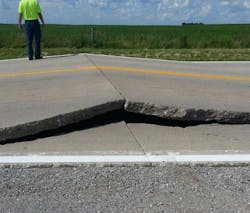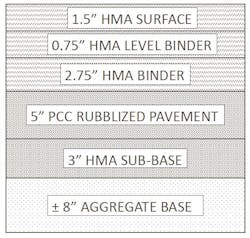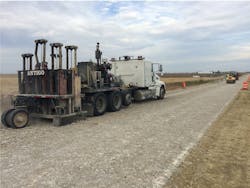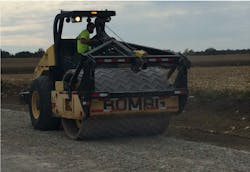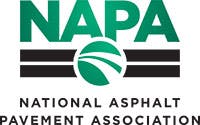Central Illinois’ Piatt County lies just west of Champaign-Urbana. A small community with a total population of about 17,000, Piatt recently stepped into the limelight of road-building innovation when it won a prestigious Perpetual Pavement Award (PPA) — only the second U.S. local public agency road project to ever receive such recognition.
PPAs are awarded by the Asphalt Pavement Alliance (APA) to road projects that have moved away from traditional construction methods to Perpetual Pavement design standards.In this case, Piatt County garnered a PPA by Conversion award by converting a deteriorating five-mile section of Monticello Road (County Highway 4) from a fiveinch white-topping concrete pavement to a multi-layer asphalt-topped roadway. This portion of the highway is expected to require only minimal upkeep.
Let’s explore Perpetual Pavement, a truly innovative approach to roadbuilding, and consider its benefits.
WHAT IS PERPETUAL PAVEMENT?
As the name implies, Perpetual Pavement refers to a particular type of asphalt roadway that’s incredibly resistant to structural fatigue. When built to specification, a Perpetual Pavement can withstand heavy use for 50 years or even longer. When it does need maintenance, it can be refreshed by simple resurfacing, never needing complete removal and replacement — meaning the driving public can enjoy a renewed surface and a comfortable ride without significant delay.
Durability is accomplished by constructing the road in layers. The design controls the bending strain within the bottom layers to prevent cracking and rutting. Consequently, designing to Perpetual Pavement standards requires careful calculations, which road owners can do using PerRoad software. The software is maintained along with a suite of other pavement design capabilities in PAVEXPRESS.
FINAL CROSS SECTION
"With increasing costs, both now and in the future, highway agencies should at least be exploring the concept of Perpetual Pavement for all future designs. The ability to limit the costs of pavement maintenance should be appealing to all highway owners."
From the bottom up, here’s how the Piatt County Perpetual Pavement project was structured:
- Bottom layer: This is typically a stabilized or unstabilized subgrade or aggregate base. On Monticello Road, five inches of existing concrete pavement were rubblized and reused for the base layer.
- Second layer: The rubblized concrete was paved over with 2.75 inches of hot-mix asphalt (HMA) binder course.
- Third layer: A thinner, 0.75-inch layer of HMA leveling course was laid on top to even out the surface.
- Top layer: The road surface was finished with a final 1.5-inch layer of HMA.
BENEFITS OF PERPETUAL PAVEMENT
While construction of the Piatt County project was performed on a road maintained by a local public agency, Perpetual Pavement projects are often employed on larger highways. Those roads tend to be heavily traveled and subject to intense wear over time. On such roads, completely replacing large sections on a regular basis is not only expensive, but is also disruptive to traffic flow and consumes a lot more material. This in turn has a negative environmental impact.
In 2020, the Federal Highway Administration issued a report citing a study of a Perpetual Pavement project conducted by the Iowa DOT. The state spent about 25% less than the engineer’s estimate, showcasing the affordability of this design methodology. Maintenance costs over the life cycle of the roadway are projected to be considerably less than with conventional pavement, with long-term savings of 17-28%. The report even cited Perpetual Pavement’s contribution to reducing the depletion of ozone, fossil fuel, and water; global warming; smog; and ecotoxicity.
While more difficult to measure, there’s a social benefit as well. Due to its ease of maintenance, Perpetual Pavement increases public satisfaction, requiring less time to maintain. This reduces construction-related traffic backups, saving fuel while simultaneously delivering the smooth ride drivers desire. It’s also safe, thanks to its resistance to structural damage over time.
THE IMPACT OF PERPETUAL PAVEMENT AWARDS
To qualify for the PPA by Conversion award, Piatt County’s Monticello Road project must be an asphalt road constructed over an existing road that meets strict criteria. Engineers at the National Center for Asphalt Technology evaluate award nominees and validate winning projects.
Other award categories include PPA by Performance (projects at least 35 years old with no structural failures and resurfacing intervals occurring at a minimum of 13 years) and PPA by Design (newly designed asphalt roads built over new or reconditioned subgrade).Eric Siebring, Piatt County engineer, says of the county’s PPA by Conversion award, “We were not only able to construct a road that will continue to perform well into the future, but we were also able to increase the safety level for the citizens of Piatt County.”
Kevin Burke III, P.E., executive vice president of the Illinois Asphalt Pavement Association, adds, “Piatt County’s Perpetual Pavement by Conversion award demonstrates how highway agencies can construct sustainable and resilient Perpetual Pavements over a rubblized base. Rubblization removes reflective cracking potential and provides a smooth surface for the traveling public while reducing maintenance issues for highway agencies. Rubblization is a flexible reconstruction option that should be considered more frequently by highway agencies for both rural and urban highways and streets.”
LOOKING AHEAD
In Piatt County, rubblizing the existing concrete roadway and using it as a base for the new one prevented the material from ending up in a landfill. But there are also the financial benefits to consider. According to Seibring, “With increasing costs, both now and in the future, highway agencies should at least be exploring the concept of Perpetual Pavement for all future designs. The ability to limit the costs of pavement maintenance should be appealing to all highway owners.”
Download the case study pdf here.
Sponsored by:

